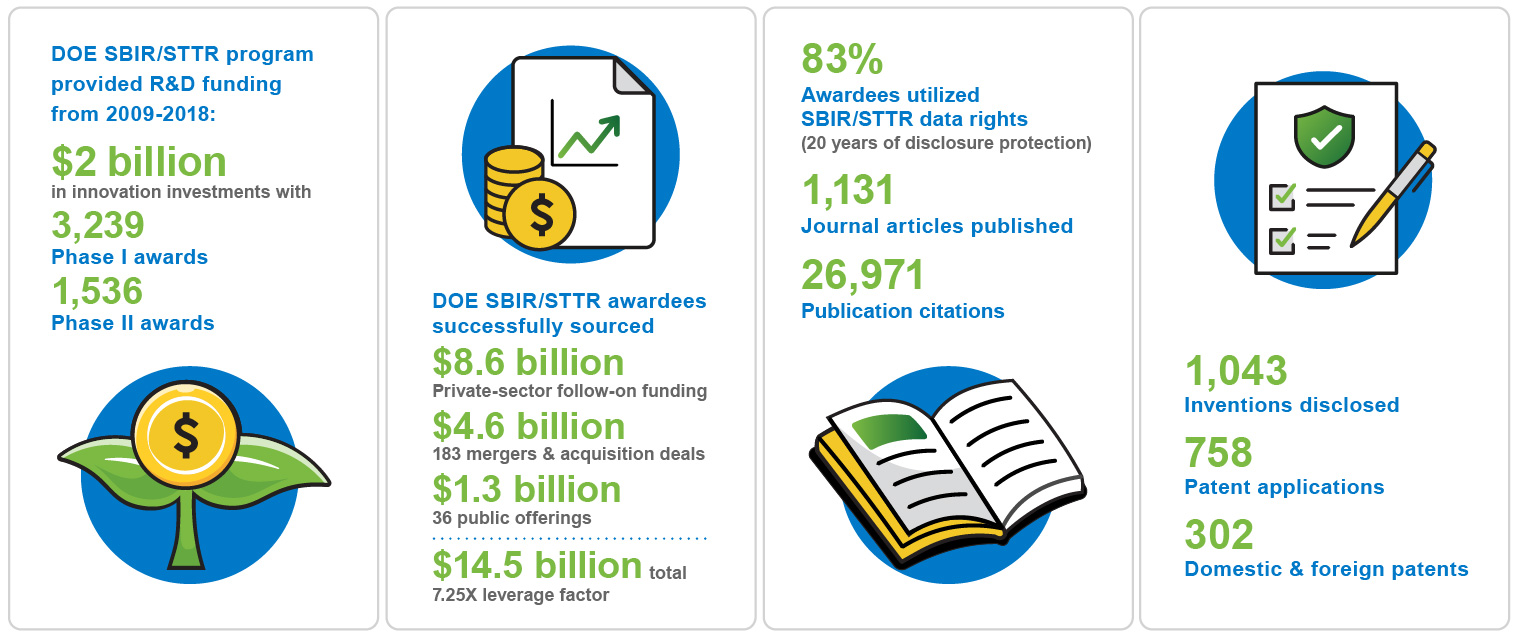Evaluation & Program Outcomes
Evaluation of the DOE SBIR/STTR Programs
Congress has directed DOE to conduct periodic evaluations of the SBIR/STTR by the National Academies of Sciences, Engineering and Medicine to assess whether these programs are meeting their goals. Electronic copies of these reports are available at no cost using the links below to the National Academies Press website. A new study is underway and expected to be issued in 2026.
- 2008 report: https://www.nap.edu/catalog/12052/an-assessment-of-the-sbir-program-at-the-department-of-energy
- 2016 report: https://www.nap.edu/catalog/23406/sbirsttr-at-the-department-of-energy
- 2020 report: https://www.nap.edu/catalog/25674/review-of-the-sbir-and-sttr-programs-at-the-department-of-energy
The NASEM studies have found that the DOE SBIR/STTR Programs are meeting the Congressional goals for the programs with the exception of increasing participation of women and socially and economically disadvantaged persons in innovation.
Past awardees were surveyed as part of the 2016 NASMEM study to assess the programs impact. Those findings are summarized below:

Program Outcomes from Recent Awards: 2009-2018
The DOE SBIR/STTR Programs Office has completed a review of recent awards to help illustrate how the advanced R&D funding through the SBIR/STTR Program addresses the goal of the programs to commercialize Federal R&D. The review included both public and Federal government data sources for private-sector financial activity (follow on funding, mergers and acquisitions, and IPOs), and intellectual property activity (publications, inventions, patents, and licensing). During the review period, from 2009-2018, the DOE SBIR/STTR Program provided approximately $2.0 billion in R&D funding to 1,240 unique small businesses across 3,239 Phase I and 1,536 Phase II awards.
For companies that received at least one grant in the study period (2009-2018), private sector financial data was sourced from PitchBook.com showed that these small businesses:
- Raised $8.6 billion in private-sector follow-on funding;
- Accounted for $4.6 billion in mergers and acquisitions activity;
- Closed on 36 initial public offerings and secondaries with a valuation estimated as $1.3 billion.
These indicators demonstrate that the SBIR/STTR Program’s approach to selecting, funding, and supporting early-stage energy R&D ensures that the U.S. not only remains at the cutting edge in energy science and engineering but also enables those innovations to achieve commercial impact.
Awardees may elect to protect their inventions through patents. A review of iEdison and United States Patent Office data for the grants made from 2009-2018 revealed:
- 1,043 inventions disclosed
- 758 patent applications
- 302 domestic and foreign patents were issued
Because of the focus on protecting and commercializing inventions, these small businesses generally elect to protect their research from disclosure compared with other research institutions that are rewarded for publishing. Per internal databases in DOE Office of Scientific and Technical Information and Web of Science:
- 83% of awards elected to utilize their SBIR/STTR data rights to prevent public disclosure of their final technical report (currently set at 20 years);
- 1,131 journal articles were published and there were 26,971 total citations of those publications.

Phase III Success Stories
The DOE SBIR/STTR Program Office investigates and documents some of the Program’s successful projects through its “Phase III Success Stories,” which explore a sampling of individual awardees and their achievements. Success stories capture in more detail the commercialization challenges that have been overcome by awardees and provide useful guidance to current awardees. In addition, many successful projects are not reflected in the private sector outcome metrics above. This may be partly the result of companies successfully “bootstrapping” their way to success. Examples include:
Similarly, private acquisitions are not fully captured by services such as Pitchbook. Recent examples include:
A catalog of the DOE SBIR/STTR Program Success Stories is available on our website: Success Stories.








